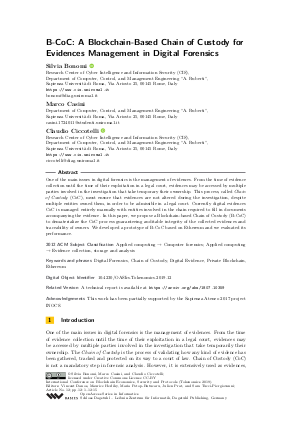B-CoC: A Blockchain-Based Chain of Custody for Evidences Management in Digital Forensics
Authors
Silvia Bonomi  ,
Marco Casini,
Claudio Ciccotelli
,
Marco Casini,
Claudio Ciccotelli 
-
Part of:
Volume:
International Conference on Blockchain Economics, Security and Protocols (Tokenomics 2019)
Part of: Series: Open Access Series in Informatics (OASIcs)
Part of: Conference: International Conference on Blockchain Economics, Security and Protocols (Tokenomics) - License:
 Creative Commons Attribution 3.0 Unported license
Creative Commons Attribution 3.0 Unported license
- Publication Date: 2020-03-17
File

PDF
OASIcs.Tokenomics.2019.12.pdf
- Filesize: 0.59 MB
- 15 pages
Document Identifiers
Related Versions
-
A technical report is available at https://arxiv.org/abs/1807.10359
Subject Classification
ACM Subject Classification
- Applied computing → Computer forensics
- Applied computing → Evidence collection, storage and analysis
Keywords
- Digital Forensics
- Chain of Custody
- Digital Evidence
- Private Blockchain
- Ethereum
Metrics
- Access Statistics
-
Total Accesses (updated on a weekly basis)
0Document
0Metadata
Abstract
One of the main issues in digital forensics is the management of evidences. From the time of evidence collection until the time of their exploitation in a legal court, evidences may be accessed by multiple parties involved in the investigation that take temporary their ownership. This process, called Chain of Custody (CoC), must ensure that evidences are not altered during the investigation, despite multiple entities owned them, in order to be admissible in a legal court. Currently digital evidences CoC is managed entirely manually with entities involved in the chain required to fill in documents accompanying the evidence. In this paper, we propose a Blockchain-based Chain of Custody (B-CoC) to dematerialize the CoC process guaranteeing auditable integrity of the collected evidences and traceability of owners. We developed a prototype of B-CoC based on Ethereum and we evaluated its performance.
Cite As Get BibTex
Silvia Bonomi, Marco Casini, and Claudio Ciccotelli. B-CoC: A Blockchain-Based Chain of Custody for Evidences Management in Digital Forensics. In International Conference on Blockchain Economics, Security and Protocols (Tokenomics 2019). Open Access Series in Informatics (OASIcs), Volume 71, pp. 12:1-12:15, Schloss Dagstuhl – Leibniz-Zentrum für Informatik (2020)
https://doi.org/10.4230/OASIcs.Tokenomics.2019.12
BibTex
@InProceedings{bonomi_et_al:OASIcs.Tokenomics.2019.12,
author = {Bonomi, Silvia and Casini, Marco and Ciccotelli, Claudio},
title = {{B-CoC: A Blockchain-Based Chain of Custody for Evidences Management in Digital Forensics}},
booktitle = {International Conference on Blockchain Economics, Security and Protocols (Tokenomics 2019)},
pages = {12:1--12:15},
series = {Open Access Series in Informatics (OASIcs)},
ISBN = {978-3-95977-108-5},
ISSN = {2190-6807},
year = {2020},
volume = {71},
editor = {Danos, Vincent and Herlihy, Maurice and Potop-Butucaru, Maria and Prat, Julien and Tucci-Piergiovanni, Sara},
publisher = {Schloss Dagstuhl -- Leibniz-Zentrum f{\"u}r Informatik},
address = {Dagstuhl, Germany},
URL = {https://drops.dagstuhl.de/entities/document/10.4230/OASIcs.Tokenomics.2019.12},
URN = {urn:nbn:de:0030-drops-119767},
doi = {10.4230/OASIcs.Tokenomics.2019.12},
annote = {Keywords: Digital Forensics, Chain of Custody, Digital Evidence, Private Blockchain, Ethereum}
}
Author Details
- Research Center of Cyber Intelligence and Information Security (CIS), Department of Computer, Control, and Management Engineering "A. Ruberti", Sapienza Università di Roma, Via Ariosto 25, 00145 Rome, Italy
- Department of Computer, Control, and Management Engineering "A. Ruberti", Sapienza Università di Roma, Via Ariosto 25, 00145 Rome, Italy
Acknowledgements
This work has been partially supported by the Sapienza Ateneo 2017 project INOCS.
References
- Geth. https://github.com/ethereum/go-ethereum/wiki/geth. [Online; accessed 30-May-2018].
- Istanbul BFT. https://github.com/ethereum/EIPs/issues/650. [Online; accessed 17-July-2018].
- Parity. https://parity.io. [Online; accessed 20-July-2018].
- Solidity. https://solidity.readthedocs.io. [Online; accessed 11-June-2018].
-
Iddo Bentov, Ariel Gabizon, and Alex Mizrahi. Cryptocurrencies Without Proof of Work. In Financial Cryptography Workshops, volume 9604 of Lecture Notes in Computer Science, pages 142-157. Springer, 2016.

- Miguel Castro and Barbara Liskov. Practical Byzantine Fault Tolerance. In Proceedings of the Third Symposium on Operating Systems Design and Implementation, OSDI '99, pages 173-186, Berkeley, CA, USA, 1999. USENIX Association. URL: http://dl.acm.org/citation.cfm?id=296806.296824.
- Satoshi Nakamoto. Bitcoin: A peer-to-peer electronic cash system, 2008. URL: http://www.bitcoin.org/bitcoin.pdf.
- Vincent Poirriez, Nicola Yanev, and Rumen Andonov. A hybrid algorithm for the unbounded knapsack problem. Discrete Optimization, 6(1):110-124, 2009. URL: https://doi.org/10.1016/j.disopt.2008.09.004.
-
Gavin Wood. Ethereum: A secure decentralised generalised transaction ledger, 2014.

